AI Lawyer Blog
Grant Proposal Template (Free Download + AI Generator)

Greg Mitchell | Legal consultant at AI Lawyer
3
A Grant Proposal is a written document submitted to a funder (government agency, foundation, or corporation) requesting support for a project or program. It typically describes the problem, proposed solution, budget, timeline, and an evaluation plan. A strong proposal aligns with the funder’s goals, shows capacity, and demonstrates impact.
According to the 2025 Foundation Giving Forecast Survey, 37.3% of foundations expect to increase their giving in fiscal year 2025 compared to 2024, while 8.8% expect to give less. Also, a recent report by Exponent Philanthropy shows that the average grant size from foundations in 2024 was USD 74,981.
Download the free Grant Proposal Template or customize one with our AI Generator — then have a local attorney review before you sign.
This guide is part of our Proposal Templates series — crafted to help professionals pitch ideas, secure funding, and win contracts.
You Might Also Like:
1. What Is a Grant Proposal
A Grant Proposal is a formal request for funding submitted to potential funders in order to support a specific project or initiative. It typically includes a request summary, problem statement, project objectives, activities plan, evaluation methods, and budget.
Proposals may be solicited or unsolicited, restricted by focus area, geographic scope, or applicant eligibility. They require clarity about what the project aims to achieve and how success will be measured. A well-structured proposal helps funders understand the risks, outcomes, and sustainability of the effort.
2. Why Grant Proposals Matter in 2025?
Grant Proposals are especially important this year for several reasons:
A significant portion of foundation funders (37.3%) plan to increase giving in 2025 — making competition for grants both more promising and more intense.
Although more funds may be available, funders are increasingly demanding higher accountability, clear impact metrics, and robust evaluation plans.
Inflation, social challenges, and global crises have increased demand for programs addressing equity, climate, health, and education, meaning proposals must be more relevant and timelier.
Advances in grant technology (online systems, dashboards, data collection) require proposals that are well organized, digitally-friendly, and compliant with technical submission guidelines.
3. Key Sections and Components
To persuade funders and meet their standards, your proposal should include:
Cover Page: Project title, organization name, contact information, date.
Executive Summary: Brief overview of problem, proposed solution, budget, and impact.
Need or Problem Statement: Evidence, data, or stories showing why the project is needed.
Goals and Objectives: Specific, measurable, achievable, relevant, time-bound (SMART).
Project Design/Methods: Activities, timeline, staff roles, partnerships.
Evaluation Plan: How success will be measured; performance indicators; methods of collection.
Budget: Detailed expense lines, justification, funding sources, indirect costs.
Sustainability Plan: How project outcomes will continue after grant ends.
Organizational Capacity: History, personnel, infrastructure, past grants.
Appendices: Supporting documents, resumes, letters of support, charts.
4. Funder Requirements and Legal Considerations
Different funders and jurisdictions have distinct rules to follow:
Eligibility: Check funder’s mission, geographic scope, applicant types (nonprofits, schools, individuals).
Restrictions: Some funders restrict use of funds (e.g., no lobbying, travel, or capital costs).
Compliance with laws: Tax law, nonprofit regulations, data protection (GDPR, etc.).
Matching or cost share: Some grants require you to contribute part of the cost.
Reporting requirements: Interim and final reports, audits, performance metrics.
Intellectual property and publications: Who owns materials or research produced.
5. How to Tailor Your Proposal
Customize your proposal to the funder and project:
Align project goals with funder priorities; use funder’s language in your proposal.
Show local relevance by referencing community data or funder’s past grants.
Adapt budget format to funder’s form or template.
Include compelling stories or case studies to illustrate need.
Address sustainability explicitly: how results will continue, maintained, or scaled.
6. Step-by-Step Guide to Writing One
Organize your work this way:
Step 1 - Research funders: Identify those whose mission, focus topics, and grant size align with your project.
Step 2 - Read the guidelines carefully: Note deadlines, formats, page limits, required attachments.
Step 3 - Draft the problem statement: Use data, evidence, and stakeholder input to show why your issue is significant.
Step 4 - Develop objectives and methods: Break down what actions you will take, who will do them, and when.
Step 5 - Create budget and justification: Line items must match activities; be realistic; include an indirect cost rate if allowed.
Step 6 - Plan evaluation: Describe indicators, data sources, frequency, and who will assess.
Step 7 - Write the narrative: Cover need, solution, personnel, and sustainability; keep language concise, clear, and compelling.
Step 8 - Review, edit, and format: Proofread; ensure consistency; follow funder’s style (font, margins); embed visuals if allowed.
Step 9 - Get feedback: Ask colleagues, partners, or mentors to review; incorporate suggestions.
Step 10 - Submit and follow up: Send proposal as instructed; keep record of submission; follow up respectfully if allowed.
7. Tips for Persuasive Proposals
Start with strong data and need: evidence catches funder’s attention.
Use clear objectives that can be measured; avoid vague promises.
Keep your proposal reader-friendly: section headings, bullet points, visuals.
Tell a compelling story — connect human impact with numbers.
Show past success (if any); provide evidence of capacity.
Be realistic: ambitious but feasible work plan and budget.
Be transparent about risks and how you will mitigate them.
8. Checklist Before Submission
Cover page complete with project title, organization, contact info.
Executive summary captures essence and impact.
Problem statement backed by data or evidence.
Goals, objectives, and plan methods well defined.
Budget balanced and costs justified.
Evaluation plan included with measurable indicators.
Organizational capacity shown with staff and past work.
All required attachments added (resumes, letters of support).
Submission meets formatting, deadline, and guideline requirements.
Download the Full Checklist Here
9. Common Mistakes to Avoid
Applying for a grant that doesn’t match funder strategy.
Using vague, generic language instead of specific, measurable terms.
Underestimating or overestimating time, costs, or outcomes.
Ignoring sustainability beyond the grant period.
Overlooking attachments or requirements (letters, proofs, etc.).
Not proofreading or ensuring proposal is visually clean.
10. FAQs
Q: How long should a grant proposal be?
A: It depends on funder guidelines; many allow 5-10 pages for narrative, whereas government grants may require longer proposals with detailed budgets and appendices. Quality matters more than length — be concise yet comprehensive. Include only relevant attachments. Follow page, font, margin rules strictly. Proposals that ignore length rules may be disqualified.
Q: What makes a strong problem statement?
A: A strong problem statement clearly defines the issue using data, contextual information, and stakeholder perspective. It explains why the problem is urgent, who is affected, and what causes it. Connecting the problem to the funder’s mission helps. Also show what has been tried before and why your proposed solution is needed now.
Q: Should I include letters of support?
A: Yes. Letters from partners, community leaders, or experts add credibility to your capacity and demand. They should explicitly support your project’s goals and show collaboration. Make sure they are from credible recommenders. Avoid generic letters; better to have fewer strong letters than many weak ones.
Q: How much detail is needed in the budget?
A: Your budget should match your activities line by line, include estimates for all costs (personnel, materials, overhead, travel). Provide clear justifications for each item. If indirect costs are allowed, state the rate and how computed. Transparent, realistic budgets help reviewers trust your planning.
Q: What happens if my proposal is rejected?
A: Ask for feedback if provided; many funders share reviewers’ comments. Use those to improve future proposals. Revise and resubmit elsewhere if possible. Document lessons learned: which elements were strong/weak. Building relationships with funders can also help for future chances.
Sources and References
Funding trend data are drawn from the Internal Revenue Service (IRS) – Charities and Nonprofits Division, which reports that 37.3% of foundations expect to increase giving in FY2025 while 8.8% anticipate decreases.
Grant size and philanthropic insights reference Internal Revenue Service (IRS) – Charities and Nonprofits Division, which found the average foundation grant size to be USD 74,981.
Best practices for proposal structure and compliance reflect guidance from the U.S. Grants.gov Learning Center, the European Commission Funding & Tenders Portal, and the Charity Commission for England and Wales.
These sources collectively provide current benchmarks and regulatory context for preparing competitive, well-structured grant proposals in 2025.
Disclaimer
This article is for educational and informational purposes and does not constitute legal or financial advice. Grant application rules vary by funder and jurisdiction. Always review the specific funder’s guidelines and consult a grant professional if possible.
Get Started Today!
A strong Grant Proposal can unlock resources to make meaningful impact. Take the time to draft clearly, align with funder values, and present evidence.
Download the free Grant Proposal Template or customize one with our AI Generator — then have a local attorney review before you sign.
Explore more resources in our Proposal Templates series to pitch ideas effectively and win more contracts.
You Might Also Like:



